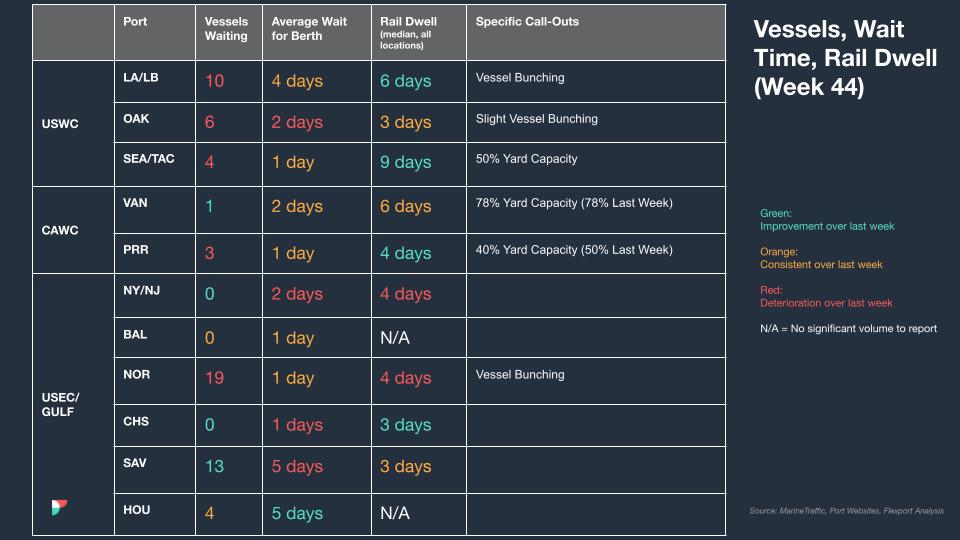Trends To Watch
- [Ocean] Panama Canal Updates: The Panama Canal has its driest October since 1950 with 41% less rainfall than usual. This is a direct impact of the decreased water levels at Lake Gatun, which not only feeds the canal but is also the main water source for 50% of Panama. Other updates include the Neo-Panamax draft restriction, which remains at 44 feet, vessel transits are now limited to 31 per day (down from a normal 36), and carriers continue to impose weight limits on shipments between 9 and 14 tonnes. There are still no noticeable delays to container transits of the canal, with the current wait time at 0.1 days for a 30-day average container ship. Despite these changes, Panama Canal routing remains the fastest transit from Asia to the U.S. East Coast and Gulf Coast. For those shipping above 14 tonnes, it’s recommended to use a via Suez service. Or, if time is critical, via U.S. or Canadian West Coast and rail. Flexport will continue to monitor the Panama Canal situation and pass on any information as it becomes available.
- [Air – Global] October’s global air cargo tonnages were nearly on par with last year, showing a mere -1% decrease year-over-year. This represents the smallest monthly drop in 2023, suggesting stabilization rather than recovery. In contrast, we saw larger declines earlier in the year, with -10% in Q1, -6% in Q2, and -3% in Q3. During week 43 specifically, tonnages dipped by -1% from the previous week with a modest +1% increase in rates. On a bi-weekly basis, there was a +3% rise in tonnages and rates coupled with a +1% increase in capacity. Regionally, significant tonnage increases were seen from Africa to Europe and within Asia-Pacific flows, while Europe to the Middle East and South Asia and North America to Europe saw decreases. Year-over-year, global chargeable weight dropped -2% with notable rises from the Middle East and South Asia, Central and South America, and Africa. Overall capacity has risen by +15% compared to last year with a significant +31% increase from Asia Pacific. Meanwhile, worldwide average rates are -28% lower than last year but still +36% higher than pre-Covid levels.
Please reach out to your account representative for details on any impacts to your shipments.
North America Vessel Dwell Times

The Week In News
Biden Administration Investing $653M in Ports To Improve Supply Chains, Keep Costs Down
The Biden administration announced it is investing over $653 million in 41 ports across the U.S., including Long Beach, Milwaukee, and Newark, using funds from the bipartisan infrastructure law. This investment aims to enhance supply chain reliability, increase port capacity, accelerate goods movement, reduce shipping costs, and decrease pollution at ports.
The Holiday Spending Outlook Is Sluggish Across Thousands of Retailers: CNBC Supply Chain Survey
As the holiday shopping season begins, a CNBC Supply Chain Survey conducted in late October among logistics executives who manage freight manufacturing orders and transportation, finds retailers are cautious about ordering large quantities due to concerns about weak consumer spending, inflation, and economic uncertainty. Major retailers have managed their excess inventories, but smaller ones are reducing stock. As the freight market experiences a downturn in volumes, and as providers exit the market or implement reductions in force, soft pricing will remain as capacity outstrips demand.
Analysis: Supply Chains in 2024—Improved, but Still Vulnerable
In 2024, the supply chain is expected to be shaped by both positive and negative factors, building upon the improvements seen in 2023 following the challenges of the COVID-19 pandemic. Supply chains are operating more smoothly with reduced congestion, a more balanced supply and demand, and an increased focus on contingency planning, flexibility, and visibility. However, traditional risks such as war, weather, and recession continue to linger in the year ahead.
